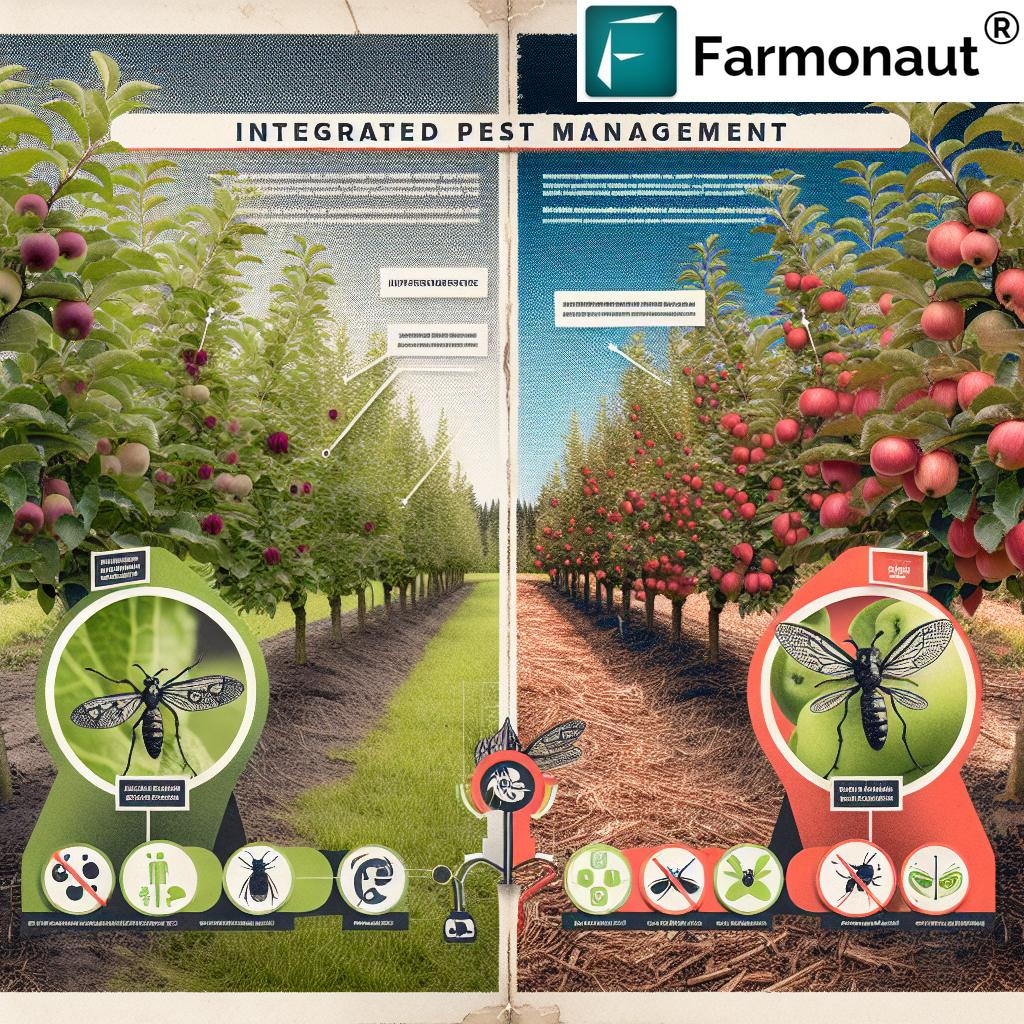Manitoba’s Green Revolution: Innovative Financing Boosts Sustainable Ammonia Production for Farmers
“Manitoba’s green ammonia initiative aims to reduce agricultural emissions by up to 30% through on-farm fertilizer production.”
In the heart of Canada’s prairies, a green revolution is taking root. Manitoba, known for its vast agricultural lands, is now at the forefront of a groundbreaking initiative that promises to transform the way we think about farming, sustainability, and energy production. We are witnessing the dawn of a new era in sustainable agriculture technology, one that combines innovative financing with cutting-edge green ammonia production systems to empower farmers and revolutionize on-farm fertilizer and fuel supply.
As we delve into this exciting development, it’s crucial to understand the significance of this leap forward in agritech solutions. This blog post will explore how the integration of precision agriculture technology with sustainable farming practices is set to reduce agricultural emissions, enhance global food security, and create a ripple effect of positive change across the agricultural landscape.
The Rise of Green Ammonia Production in Manitoba
At the core of this agricultural revolution is the concept of green ammonia production. But what exactly is green ammonia, and why is it so important for the future of farming?
- Green ammonia is produced using renewable energy sources, unlike traditional ammonia production which relies heavily on fossil fuels.
- It serves as both a sustainable fertilizer and a potential clean fuel source.
- On-farm production systems reduce reliance on external supply chains and decrease transportation-related emissions.
In Manitoba, the push for green ammonia production is gaining significant traction, thanks to innovative companies like FuelPositive Corporation. Their pioneering efforts in developing farmer-owned, on-farm green ammonia production systems are setting new standards for sustainable agriculture technology.

Innovative Financing: The Catalyst for Change
The transition to sustainable farming practices often faces a significant hurdle: financing. However, Manitoba is showcasing how innovative financing models can accelerate the adoption of green technologies in agriculture.
On December 4, 2024, FuelPositive Corporation announced a groundbreaking financing initiative that aims to propel the activation of its first green ammonia production system and kickstart revenue streams. This development is a testament to the growing interest and belief in sustainable agricultural solutions.
Key Elements of the Financing Initiative:
- Commitment from long-term shareholders and new investors, including local Manitoba farmers
- Funding for final pressure vessel certification and third-party engineering certifications
- Integration of the system into Manitoba’s green grid
- Private placement offering of up to 26,666,667 units at $0.03 each
- Anticipated raise of up to $800,000
This financing model demonstrates a collaborative approach, bringing together investors, farmers, and technology providers to drive forward sustainable agriculture technology. It’s a prime example of how agritech financing can be structured to support innovative farming solutions.
The FP300: A Game-Changer in On-Farm Fertilizer Systems
At the heart of this green revolution is FuelPositive’s FP300 system, a pioneering technology in decentralized fuel production. This innovative farming solution is designed to be owned and operated by farmers themselves, marking a significant shift in how agricultural inputs are produced and distributed.
Features of the FP300 System:
- On-site green ammonia production
- Modular design for scalability
- Significant reduction in carbon emissions
- Integration with existing farm infrastructure
The delivery of the first commercial FP300 system to a grain farm in Manitoba in June 2024 was a milestone event. It signaled the beginning of a new chapter in sustainable farming practices, showcasing the practical application of precision agriculture technology in real-world farming scenarios.
Environmental Impact and Agricultural Emissions Reduction
One of the most compelling aspects of the green ammonia production systems is their potential for significant agricultural emissions reduction. Traditional ammonia production is a major contributor to greenhouse gas emissions in the agricultural sector. By transitioning to on-farm, renewable energy-powered ammonia production, we can dramatically cut down these emissions.
“The sustainable ammonia project in Manitoba is expected to create over 500 new jobs in engineering and sciences.”
Environmental Benefits:
- Reduction of up to two tons of CO2e for every ton of ammonia produced
- Decreased reliance on fossil fuels in fertilizer production
- Minimized transportation emissions due to on-site production
- Potential for carbon credits and environmental incentives
These environmental gains align perfectly with global efforts to combat climate change and promote sustainable farming practices. They also position Manitoba as a leader in green agricultural innovation, setting a benchmark for other regions to follow.
Integration with Manitoba’s Green Grid
A crucial aspect of the FuelPositive initiative is the integration of their green ammonia production systems with Manitoba’s green grid. This synergy between sustainable energy production and agricultural technology exemplifies the holistic approach needed to create truly sustainable farming ecosystems.
Benefits of Green Grid Integration:
- Utilization of renewable energy sources for ammonia production
- Potential for energy storage and grid stabilization
- Reduced strain on traditional energy infrastructure
- Creation of a circular economy within the agricultural sector
The integration with the green grid not only enhances the sustainability of the ammonia production process but also contributes to the overall resilience and efficiency of Manitoba’s energy system. It’s a prime example of how innovative farming solutions can have far-reaching impacts beyond the farm gate.

Stakeholder Support and Government Initiatives
The success of this green ammonia initiative in Manitoba is largely due to the broad support it has garnered from various stakeholders. Government bodies, academic institutions, and agricultural organizations have all recognized the transformative potential of this technology.
Key Stakeholder Contributions:
- Provincial funding initiatives to cover remaining activation costs
- Academic partnerships for research and development
- Agricultural sector endorsements highlighting the technology’s benefits
- Government support for sustainable development and clean energy adoption
This multi-faceted support system demonstrates the collaborative effort required to bring innovative farming solutions from concept to reality. It also underscores the importance of public-private partnerships in driving agricultural innovation.
Economic Impact and Job Creation
Beyond its environmental benefits, the green ammonia project in Manitoba is set to have a significant economic impact. The creation of a center of excellence in Green Ammonia production is expected to boost local employment, particularly in engineering and sciences.
Economic Benefits:
- Creation of high-skilled jobs in the green technology sector
- Increased investment in research and development
- Potential for technology exports and knowledge transfer
- Strengthening of Manitoba’s position as a leader in agritech innovation
This economic boost aligns perfectly with the global trend towards green job creation and sustainable economic development. It positions Manitoba not just as an agricultural powerhouse, but as a hub for green technology innovation.
Precision Agriculture Technology: The Role of Satellite Monitoring
While on-farm ammonia production is a crucial component of this green revolution, it’s important to recognize the role of other precision agriculture technologies in supporting sustainable farming practices. Satellite-based monitoring systems, like those offered by Farmonaut, play a vital role in optimizing resource use and enhancing crop yields.
Benefits of Satellite Monitoring in Agriculture:
- Real-time crop health monitoring
- Optimization of irrigation and fertilizer use
- Early detection of pest and disease issues
- Improved decision-making for farm management
The integration of satellite monitoring with green ammonia production systems creates a powerful synergy, allowing farmers to precisely apply their sustainably produced fertilizers for maximum efficiency and minimal environmental impact.
Global Food Security and Sustainable Farming Practices
The implications of Manitoba’s green ammonia initiative extend far beyond the province’s borders. By demonstrating the viability of sustainable, decentralized fertilizer production, this project contributes significantly to global food security efforts.
Global Impact:
- Reduced dependence on volatile global fertilizer markets
- Increased resilience of local food systems
- Potential for technology transfer to developing agricultural regions
- Contribution to global greenhouse gas reduction targets
As the world grapples with the challenges of feeding a growing population in the face of climate change, innovative farming solutions like those being implemented in Manitoba offer a beacon of hope. They showcase how technology and sustainability can work hand in hand to secure our food future.
Comparative Analysis: Green Ammonia vs. Traditional Production
To fully appreciate the impact of green ammonia production, it’s essential to compare it with traditional methods. The following table provides a clear overview of the key differences:
| Production Method | Estimated CO2 Emissions (tons/year) | Energy Efficiency (%) | Estimated Cost per Ton ($) | On-Farm Feasibility | Government Incentives Available |
|---|---|---|---|---|---|
| Traditional Centralized Ammonia Production | 1.8 – 3.0 | 30-40% | 400-600 | Low | No |
| On-Farm Green Ammonia Production | 0.1 – 0.3 | 60-70% | 300-500 | High | Yes |
This comparison clearly illustrates the advantages of green ammonia production, particularly in terms of emissions reduction, energy efficiency, and on-farm feasibility. The availability of government incentives further enhances the attractiveness of this sustainable option for farmers.
The Future of Sustainable Agriculture in Manitoba and Beyond
As we look to the future, the green ammonia initiative in Manitoba serves as a model for sustainable agriculture worldwide. It demonstrates how innovative farming solutions, when combined with supportive financing and policy frameworks, can drive significant change in the agricultural sector.
Future Prospects:
- Expansion of green ammonia production to other regions
- Further integration with renewable energy systems
- Development of ammonia as a clean fuel for agricultural machinery
- Creation of circular economies within farming communities
The journey towards truly sustainable agriculture is ongoing, but initiatives like the one in Manitoba are paving the way for a greener, more resilient future for farming.
Embracing Technology for Sustainable Farming
As we’ve seen throughout this exploration of Manitoba’s green ammonia initiative, technology plays a crucial role in advancing sustainable agriculture. From on-farm production systems to satellite monitoring, the integration of innovative technologies is key to creating more efficient, environmentally friendly farming practices.
For farmers looking to embrace these technologies, there are numerous resources available. Farmonaut, for instance, offers advanced satellite-based farm management solutions that complement sustainable farming practices. Their platform provides valuable tools for crop health monitoring, resource management, and data-driven decision-making.
Explore Farmonaut’s offerings:
For developers interested in integrating agricultural data into their own systems, Farmonaut also offers an API with comprehensive developer documentation.
Conclusion: A Green Future for Manitoba’s Agriculture
Manitoba’s green revolution in sustainable ammonia production represents a significant leap forward in agricultural technology and sustainability. By combining innovative financing, cutting-edge technology, and a commitment to environmental stewardship, the province is setting a new standard for sustainable farming practices.
The benefits of this initiative extend far beyond the farm gate. From reducing agricultural emissions and enhancing global food security to creating new jobs and fostering innovation, the impact of this green ammonia project is truly transformative. As we move forward, it’s clear that the future of agriculture lies in embracing such innovative farming solutions, supported by precision agriculture technology and sustainable practices.
Manitoba’s journey serves as an inspiration and a roadmap for other regions looking to transform their agricultural sectors. It demonstrates that with the right combination of technology, policy support, and farmer engagement, we can create a more sustainable, resilient, and productive agricultural system that benefits farmers, consumers, and the planet alike.
FAQ Section
- Q: What is green ammonia, and how does it differ from traditional ammonia production?
A: Green ammonia is produced using renewable energy sources, unlike traditional ammonia which relies on fossil fuels. This results in significantly lower carbon emissions and a more sustainable production process. - Q: How does on-farm green ammonia production benefit farmers?
A: On-farm production allows farmers to produce their own fertilizer, reducing dependency on external supply chains, lowering costs, and ensuring a stable supply of this crucial input. - Q: What role does precision agriculture technology play in this green revolution?
A: Precision agriculture technologies, such as satellite monitoring, help optimize the use of resources like fertilizers and water, complementing the benefits of green ammonia production. - Q: How is the Manitoba government supporting this initiative?
A: The Manitoba government is providing funding support and creating policies that encourage the adoption of sustainable agricultural practices, including green ammonia production. - Q: Can this technology be implemented in other regions?
A: Yes, while the initiative is currently focused in Manitoba, the technology has the potential to be adapted and implemented in other agricultural regions worldwide.
















